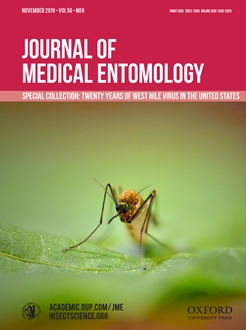Filth flies live in close proximity to humans and livestock and transmit pathogens. Current control relies on chemical insecticides, and flies can develop resistance to these insecticides. The public is also interested in natural and safer insecticides. Therefore, alternative pesticides compatible with the synanthropic nature of flies are needed. Four plant aliphatic methyl ketones were evaluated for control of adult house flies, Musca domestica L., blow flies, Cochliomyia macellaria (F.), and gray flesh flies, Sarcophaga bullata (Parker). In sealed petri dish assays, 2-heptanone, 2-octanone, 2-nonanone, and 2-undecanone exhibited fumigant activity against house flies with 24-h LC50s of 6.9, 7.5, 8.0, and 9.2 µg/cm3, respectively. Further research focused on undecanone (a U.S. EPA-registered biopesticide). When tested in larger enclosures at 1.7, 2.3, and 2.8 µg/cm3, undecanone provided 60.4, 82.2, and 94.4% house fly mortality; 56.9, 75.6, and 92.5% flesh fly mortality; and 62.1, 84.5, and 97.9% blow fly mortality, respectively, after a 2-h exposure. In a two-choice behavioral assay with 194.6 µg/ cm2 of the test compound on the treatment versus an untreated surface of the same area, the overall mean repellencies for blow flies were 84.7% for undecanone versus 87.6% for N,N-diethyl-meta-toluamide (DEET). For house flies, mean repellencies were 80.7% for undecanone and 84.9% for DEET. The house fly topical LD50 for undecanone was 58.1 µg per fly. Undecanone was far less expensive for filth fly control than the gold standard for insect fumigation, methyl bromide.
How to translate text using browser tools
26 June 2019
Control of Filth Flies, Cochliomyia macellaria (Diptera: Calliphoridae), Musca domestica (Diptera: Muscidae), and Sarcophaga bullata (Diptera: Sarcophagidae), Using Novel Plant-Derived Methyl Ketones
Jean M. Deguenon,
Jiwei Zhu,
Steven Denning,
Michael H. Reiskind,
David W. Watson,
R. Michael Roe
ACCESS THE FULL ARTICLE
It is not available for individual sale.
This article is only available to subscribers.
It is not available for individual sale.
It is not available for individual sale.

Journal of Medical Entomology
Vol. 56 • No. 6
September 2019
Vol. 56 • No. 6
September 2019
2-undecanone
fumigant
methyl bromide
methyl ketone
repellent




